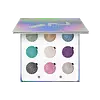What's inside
What's inside
 Key Ingredients
Key Ingredients

 Benefits
Benefits

 Concerns
Concerns

 Ingredients Side-by-side
Ingredients Side-by-side

Mica
Cosmetic ColorantZinc Stearate
Cosmetic ColorantBoron Nitride
AbsorbentAluminum Starch Octenylsuccinate
AbsorbentMagnesium Aluminum Silicate
AbsorbentSilica
AbrasiveTrimethylsiloxysilicate
EmollientDimethicone
EmollientEthylene/Acrylic Acid Copolymer
Emulsion StabilisingPhenoxyethanol
PreservativeEthylhexylglycerin
Skin ConditioningCI 77163
Cosmetic ColorantCI 77891
Cosmetic ColorantCI 77492
Cosmetic ColorantCI 77491
Cosmetic ColorantTitanium Dioxide
Cosmetic ColorantIron Oxides
Polybutylene Terephthalate
Bis-Diglyceryl Polyacyladipate-2
EmollientAcrylates Copolymer
Ethylene/Va Copolymer
Emulsion StabilisingPolyethylene Terephthalate
Polyglyceryl-2 Triisostearate
EmulsifyingMethylpropanediol
SolventPropanediol
SolventCalcium Titanium Borosilicate
AbrasiveCalcium Aluminum Borosilicate
CI 77891
Cosmetic ColorantDiphenylsiloxy Phenyl Trimethicone
Skin ConditioningPolypropylene
Octyldodecanol
EmollientDiisostearyl Malate
EmollientHydrogenated Castor Oil Dimer Dilinoleate
Skin ConditioningPhytosteryl/Isostearyl/Cetyl/Stearyl/Behenyl Dimer Dilinoleate
Skin ConditioningSilica
AbrasiveCalcium Sodium Borosilicate
Mica
Cosmetic ColorantSynthetic Fluorphlogopite
Disteardimonium Hectorite
StabilisingPropylene Carbonate
SolventCI 77491
Cosmetic ColorantCI 75470
Cosmetic ColorantTriethoxycaprylylsilane
Octyldodecyl Stearoyl Stearate
EmollientPhenylpropyldimethylsiloxysilicate
EmollientMagnesium Stearate
Cosmetic ColorantTrimethylsiloxysilicate
EmollientHydrogenated Polydecene
EmollientEthylene/Propylene Copolymer
AbrasiveCI 77510
Cosmetic ColorantCI 15985
Cosmetic ColorantIsododecane
EmollientNylon-12
Phenyl Trimethicone
Skin ConditioningMagnesium Myristate
Polybutene
Dimethicone
EmollientAluminum Distearate
Emulsion StabilisingDimethicone/Vinyl Dimethicone Crosspolymer
Skin ConditioningPhenoxyethanol
PreservativePolyurethane-11
CI 15850
Cosmetic ColorantCI 19140
Cosmetic ColorantCI 77000
Cosmetic ColorantWater
Skin ConditioningPolybutylene Terephthalate, Bis-Diglyceryl Polyacyladipate-2, Acrylates Copolymer, Ethylene/Va Copolymer, Polyethylene Terephthalate, Polyglyceryl-2 Triisostearate, Methylpropanediol, Propanediol, Calcium Titanium Borosilicate, Calcium Aluminum Borosilicate, CI 77891, Diphenylsiloxy Phenyl Trimethicone, Polypropylene, Octyldodecanol, Diisostearyl Malate, Hydrogenated Castor Oil Dimer Dilinoleate, Phytosteryl/Isostearyl/Cetyl/Stearyl/Behenyl Dimer Dilinoleate, Silica, Calcium Sodium Borosilicate, Mica, Synthetic Fluorphlogopite, Disteardimonium Hectorite, Propylene Carbonate, CI 77491, CI 75470, Triethoxycaprylylsilane, Octyldodecyl Stearoyl Stearate, Phenylpropyldimethylsiloxysilicate, Magnesium Stearate, Trimethylsiloxysilicate, Hydrogenated Polydecene, Ethylene/Propylene Copolymer, CI 77510, CI 15985, Isododecane, Nylon-12, Phenyl Trimethicone, Magnesium Myristate, Polybutene, Dimethicone, Aluminum Distearate, Dimethicone/Vinyl Dimethicone Crosspolymer, Phenoxyethanol, Polyurethane-11, CI 15850, CI 19140, CI 77000, Water
 Reviews
Reviews

Ingredients Explained
These ingredients are found in both products.
Ingredients higher up in an ingredient list are typically present in a larger amount.
Ci 77491 is also hydrated iron III oxide. It's sole purpose is to give a red/pink hue to products.
Iron III oxides are classified as inorganic chemicals for coloring.
Synthetically created Ci 77491 is considered safer than those naturally found. This is because the synthetically created version may contain less impurities. Iron oxides are generally non-toxic and non-allergenic.
Learn more about CI 77491Ci 77891 is a white pigment from Titanium dioxide. It is naturally found in minerals such as rutile and ilmenite.
It's main function is to add a white color to cosmetics. It can also be mixed with other colors to create different shades.
Ci 77891 is commonly found in sunscreens due to its ability to block UV rays.
Learn more about CI 77891Dimethicone is a type of synthetic silicone created from natural materials such as quartz.
What it does:
Dimethicone comes in different viscosities:
Depending on the viscosity, dimethicone has different properties.
Ingredients lists don't always show which type is used, so we recommend reaching out to the brand if you have questions about the viscosity.
This ingredient is unlikely to cause irritation because it does not get absorbed into skin. However, people with silicone allergies should be careful about using this ingredient.
Note: Dimethicone may contribute to pilling. This is because it is not oil or water soluble, so pilling may occur when layered with products. When mixed with heavy oils in a formula, the outcome is also quite greasy.
Learn more about DimethiconeMica is a naturally occurring mineral used to add shimmer and color in cosmetics. It can also help improve the texture of a product or give it an opaque, white/silver color.
Serecite is the name for very fine but ragged grains of mica.
This ingredient is often coated with metal oxides like titanium dioxide. Trace amounts of heavy metals may be found in mica, but these metals are not harmful in our personal products.
Mica has been used since prehistoric times throughout the world. Ancient Egyptian, Indian, Greek, Roman, Aztec, and Chinese civilizations have used mica.
Learn more about MicaPhenoxyethanol is a preservative that has germicide, antimicrobial, and aromatic properties. Studies show that phenoxyethanol can prevent microbial growth. By itself, it has a scent that is similar to that of a rose.
It's often used in formulations along with Caprylyl Glycol to preserve the shelf life of products.
Silica, also known as silicon dioxide, is a naturally occurring mineral. It is used as a fine, spherical, and porous powder in cosmetics.
Though it has exfoliant properties, the function of silica varies depending on the product.
The unique structure of silica enhances the spreadability and adds smoothness, making it a great texture enhancer.
It is also used as an active carrier, emulsifier, and mattifier due to its ability to absorb excess oil.
In some products, tiny microneedles called spicules are made from silica or hydrolyzed sponge. When you rub them in, they lightly polish away dead skin layers and enhance the penetration of active ingredients.
Learn more about SilicaThis silicone is an emollient. Emollients create a thin film on the skin to prevent moisture from escaping.
It is not soluble in water and helps increase water-resistance in products.
According to a manufacturer, it can blend seamlessly with silicone oils, such as Cyclopentasiloxane.
Learn more about Trimethylsiloxysilicate